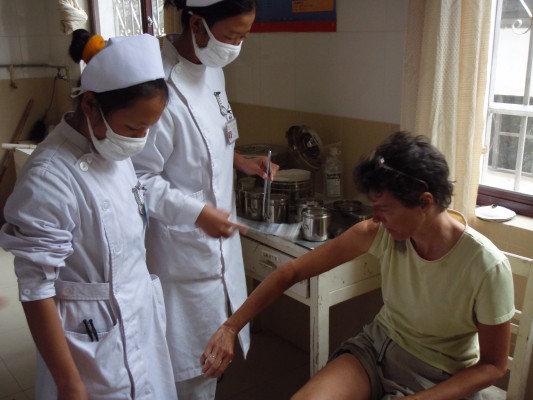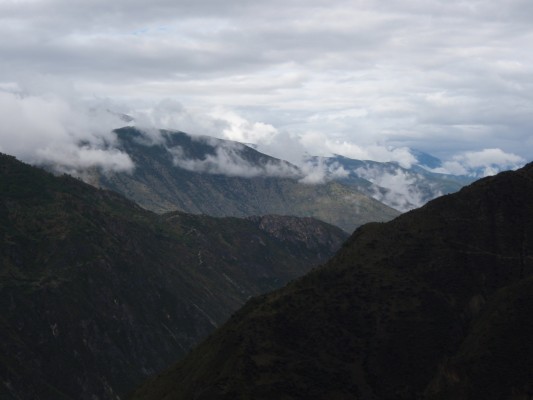This interesting thing about this is there were twice as many people before I took out the camera to video. Chinese do not like to be photographed as a part of a crowd, and yet they always like to be a part of a crowd. I wonder if it has to do with how much they are under surveillance, or think they are?
Tag Archives: Adventure Travel
Our trip through the back country of Shangri-la turned out to be four days instead of two, due to a landslide and constant big (still) mountains.
Bob:
Yesterday we took a little detour on our way into Lijaing – to the hospital. We crashed. A combination of a long day, with 1200 more meters of climbing, a patch of water laid down by the cooling water of a truck’s brakes, a little bit of clay, and down we went at about 30kph.
Claire was not responding at first and I got her out of traffic carefully, in case any bones were broken (none). I can’t explain how I felt seeing her, barely moving, having trouble hearing me, or answering to her name. She finally came around, and I got her sitting upright and talking coherently. I checked her eyes for dilation or wandering, and she could focus and had no double vision (we’ve been through this before).
A motorcyclist helped direct traffic as I dragged Zippy to the edge. I started to search for the first aid kit, and by then Claire was thinking clearly enough to tell me where to find it. Before I could start cleaning her abrasions, a van full of police arrived. My first thought was that we were in even more trouble than the crash aftermath, but they were great. “We take you to hospital,” said with authority, had an amazingly calming effect. They commandeered a small pickup, and loaded Zippy in. We wondered if we’d ever see him again, until we saw one of the policemen get into the truck.
Claire:
It’s really frustrating having to admit you need help, but when the police came and said “hospital” I knew we probably should go, even though it meant transporting Zippy some other way, struggling to communicate with doctors or nurses, arriving in an unfamiliar town not under your own power, and worst of all, losing your bearings.
Since I’d lost a minute or two, I had a lot of questions for Bob and it took me a while to come out of the fog that makes you think you’re having a bad dream. I remember knowing we were going down, but that’s all.
At the hospital, we had our scrapes swabbed. They thought my nose might be broken, but I think my glasses just gouged it. I took the hit evenly between shoulder and hip. Bob got it pretty bad on the knee, but it hasn’t swollen. Bob noticed the doctor watching me for signs of brain trauma, and from previous experience, he knew to wake me in the middle of the night to make sure I knew who and where I was. We’re both a little stiff and sore today, so we’ll take an extra day in our three star hotel. (Total hospital bill: $6)
We’ll post our days in the back country soon. Beautiful…
Another day, another two mountains. When we reached the Yangtze we thought we would be cruising down the river for a few days, but China 214 took a hard left into a narrow gorge where we found yesterday’s accommodations.
We began this morning in the rain. The mountain ahead – a 1,000 meter climb – looked grim, with tatters of gray rain hanging from charcoal clouds. Rain dripped from our parka hoods, spray from trucks and small streams crossing the road had wet us thoroughly. We settled in to listening to Zippy creak and grind in the wet and grit.
We stopped often for moon cakes and Tang, our primary power sources these days, and plodded on at the reasonable pace of 6 to 8kph (about 4 to 5mph) for a couple of hours. The road made a switchback that took us away from the rain and we slowly began to dry. An hour or so later, we topped out for a few kilometers of descent and began another 500m climb, with rain threatening the summit.
Claire:
Our day was made sunnier by the friendly Chinese tourists foisting food on us. At one point, we had to reject a girl who was on her third trip to give us fruit and moon cakes. We were already loaded down with walnuts from this morning.
We also had a great exchange with some other bike tourists. David and Maria from Bilbao, Spain are going north. I felt bad that they seemed anxious about how high the climbs were and we couldn’t tell them anything encouraging; yes, there would be some very hard all-day climbs ahead. I know exactly how that feels, but during the climb it doesn’t seem so bad after all.
David gave us a map he would no longer need and I gave him my notes transcribed from Mark and Julie McLean’s great website: Mark-Ju.net. Julie’s detailed description through this last segment was spot on.
We are seeing some of the plants we all take for granted as garden plants here in the West, but originated here. It was Joseph Rock’s explorations in these mountains that began the garden boom in England, and subsequently the Western World. An English author read a story in National Geographic, and based his mythical Shangri-la on Joseph Rock’s cultural observations as an aside to his botanical work. So it is in quite a round-about way that the Shangri-la no-tell-motel on the seedy side of town is named “Shangri-la.”
Still Shangri-la?
Is this part of China still Shangri-la? For many of the people content to live the simple life of farm work and devotion to Buddhism, it still must be a peaceful existence. They watch the world pass and wonder at it, but have little desire to follow it to the cities. Of course, some of the young do follow China 214 to the city, and village life no doubt suffers for their loss. The outside world nibbles at the edges of their world, but so far makes seemingly minor inroads. We see a village high on the mountain as we pedal the China 214, and wonder at how they possibly can get up there, how they found a place to put a house – let alone a barn, and those terraced fields. A few hundred meters is a long way when the slope is 45 degrees.
Are they the healthy happy people who live long lives, as described in the novel? Their smiles indicate they are happy. As for their health, they must have strong hearts to navigate the near vertical hillsides all day – every day. Their sanitary systems are nonexistent, but they’ve probably adapted to some degree, and all consumed water is boiled.
Many of them live as my grandfather lived in West Virginia more than 100 years ago. He was still mowing hay by hand when he was 90 years old. He worked with horses, had no electricity, went to the outhouse, ate pork every day, and died peacefully at home at 93.
Shangri-la? Not for us, but considering the challenges of modern life, and that American’s life spans are decreasing for the first time ever, perhaps there are lessons to be learned.
Claire took a nice video of a man dragging logs with a team of oxen that reminded us that we were in a world not wholly made up of diesel belching trucks, wildly driven SUVs, and kilometer long lines of tourist cars.
The National Holiday
We are in the middle of one of two national holidays in China. All Chinese who can afford it, and there are many more than four years ago, want to drive their personal autos to some tourist hot spot. We are entering the area defined by the tourist industry as “Shangri-la,” and it is apparently a prime destination.
We’ve had our picture taken so many times by so many Han Chinese, with their huge Canons and Nikons, that I am considering declaring us an official minority and charging for our images. One time it was a huge tour bus filled with photographers, wearing camera vests and sporting lenses larger than both of our cameras put together.
It gives me a new perspective on photographing people. When I was a photojournalist I often just charged into a group and began knocking off frames at a furious pace, with no consideration of the feelings of the people. I don’t have to do that any more. Now I ask, or am so unobtrusive that I don’t disturb the flow of their lives.
Claire shoots from the back of the tandem, and that seems to disarm people. We also get a kick out of the Chinese amateur photographers, scrambling for the best angle, jabbering away, finally waving and giving a thumbs up; it’s all road entertainment for us.
Shangri-la, The City
After a short descent to a large lake which seems to be a major tourist attraction, judging from the traffic jams, we again rode in the rain into the city of Shangri-la. Claire was surprised at the size of the city, and despaired of finding the guest house we sought. We finally found it, paying eight times what we paid the previous night for the privilege of hearing our neighbors, and choking on their smoke that seeps through the walls. The extra price is for arriving during the national holiday; the Chinese also pay the higher fee.
So far it seems like any other medium sized city, except there are many more hotels (all full). There is a tourist “Old Town” that we must see while we are here.
We’re off on a back road trip to Tiger Leaping Gorge. Claire says more mountains are ahead of us – and no doubt some spectacular scenery.
save
You might wonder why we don’t find better accommodations? The next Bingwan was 84 kilometers, and 1500 meters up the road, a hard all day ride. Sometimes the basics seem awfully nice after a long hard day, with another one waiting.
October 3
Shangri-la is changing as we drop in elevation. The yaks are gone, replaced by mixed breed cows, sheep, goats and donkeys. The high meadows, empty of human habitation, other than seasonal tents, with sparkling air and clear water, have been replaced with terraced fields of crops, villages with substantial houses, roofs filled with drying corn and racks with hay. The people remain friendly and vocal as we pass, our unusual mode of transportation a novelty still.
But there is a change. The prayer flags, stupas and monasteries are fewer, the flags more likely to be tattered and faded, and the architecture increasingly Han and not Tibetan. There have been a few instances of architecture new to us, indicating we are entering an area of more diverse ethnicity. Groups of women walk in brightly decorated dresses and several varieties of head dress.
Today was a nearly perfect cycling day: the road was smooth, and mostly downhill, with just enough cooling upstream breeze. We had a few hills, but none were long. There were friendly people, cute donkeys and goats, spectacular gorge scenery, and all our official interactions at check stations were pleasant. I’m beginning to think we just got a couple of bad eggs, on edge because of the 60th anniversary of Communist China’s founding. The army was even guarding a bridge, complete with sand bagged bunkers, though they seemed relaxed, perhaps because the day, October 1, has come and gone without incident, as far as we know. Unescorted foreigners are still blocked from the Tibetan Autonomous Region, though that was supposed to be lifted this week.








